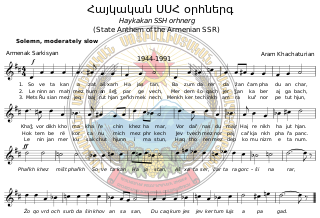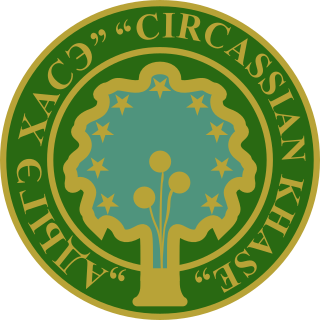
The State Anthem of the Union of Soviet Socialist Republics was the national anthem of the Soviet Union and the regional anthem of the Russian Soviet Federative Socialist Republic from 1944 to 1991, replacing "The Internationale". Its original lyrics were written by Sergey Mikhalkov (1913–2009) in collaboration with El-Registan (1899–1945), and its music was composed by Alexander Alexandrov (1883–1946). For a two-decade interval following de-Stalinization, the anthem was performed without lyrics. The second set of lyrics, also written by Mikhalkov and in which Stalin's name was omitted, was adopted in 1977.

The State Anthem of the Armenian Soviet Socialist Republic was the national anthem of Armenia when it was a republic of the Soviet Union and known as the Armenian Soviet Socialist Republic. It was used between 1944 and 1991. Its music was composed by Armenian composer Aram Khachaturian, and the lyrics were written by Sarmen. Along with the Anthem of the Estonian SSR, it is one of the only two SSR anthems without an intro.

The Republic of Adygea, also known as the Adygean Republic, is a republic of Russia. It is situated in the North Caucasus of Eastern Europe. The republic is a part of the Southern Federal District, and covers an area of 7,600 square kilometers (2,900 sq mi), with a population of roughly 496,934 residents. It is an enclave within Krasnodar Krai and is the fifth-smallest Russian federal subject by area. Maykop is the capital and the largest city of Adygea, home to one-third of the republic's population.

Maykop is the capital city of Adygea, Russia, located on the right bank of the Belaya River. It borders Maykopsky District, from which it is administratively and municipally independent, to the east and south; Giaginsky District to the north, and Belorechensky District of Krasnodar Krai to the west.

The Circassians or Circassian people, also called Cherkess or Adyghe are a Northwest Caucasian ethnic group and nation who originated in Circassia, a region and former country in the North Caucasus. As a consequence of the Circassian genocide, which was perpetrated by the Russian Empire during the Russo-Circassian War in the 19th century, most of the Circassian people were exiled from their ancestral homeland and consequently began living in what was then the Ottoman Empire—that is, modern-day Turkey and the rest of the Middle East. In the early 1990s, the Unrepresented Nations and Peoples Organization estimated that there are as many as 3.7 million Circassians in diaspora in over 50 countries.

Adyghe is a Northwest Caucasian language spoken by the western subgroups of Circassians. It is spoken mainly in Russia, as well as in Turkey, Jordan, Syria and Israel, where Circassians settled after the Circassian genocide by the Russian Empire. It is closely related to the Kabardian language, though some reject the distinction between the two languages in favor of both being dialects of a unitary Circassian language.

Giaginsky District is an administrative and a municipal district (raion), one of the seven in the Republic of Adygea, Russia. It is located in the northern central portion of the republic and borders with Shovgenovsky District in the north, Koshekhablsky District in the east and northeast, Mostovsky District of Krasnodar Krai in the southeast, Maykopsky District in the south, and with Belorechensky District of Krasnodar Krai in the west. The area of the district is 756.54 square kilometers (292.10 sq mi). Its administrative center is the rural locality of Giaginskaya. As of the 2010 Census, the total population of the district was 31,766, with the population of Giaginskaya accounting for 44.5% of that number.

Circassian, also known as Cherkess, is a subdivision of the Northwest Caucasian language family, spoken by the Circassian people. There are two Circassian languages, defined by their literary standards, Adyghe, with half a million speakers, and Kabardian, with a million. The languages are highly mutually intelligible with one another, but differ to a degree where they would be considered clear-cut dialects. The earliest extant written records of the Circassian languages are in the Arabic script, recorded by the Turkish traveller Evliya Çelebi in the 17th century, although the Greek and Georgian alphabets were adapted for them in ancient and medieval times.

The Shapsug are one of the twelve major Circassian tribes. Historically, the Shapsug tribe comprised one of the largest groups of the Black Sea Adyghe. They inhabited the region between the Dzhubga River and the Shakhe Rivers and high-altitude mountainous areas of the northern slopes of the Caucasus range along the Antkhir, Abin, Afips, Bakan, Ships, and other rivers . In Russia, the remaining Shapsug population mainly live in the Tuapsinsky District (Tuapse) of Krasnodar Krai, Lazarevsky City District of Sochi, and in the Republic of Adygea, which were a small part of historical Circassia.

The Circassian flag is the national flag of the Circassians. It consists of a green field charged with twelve gold stars, nine forming an arc resembling a bow and three horizontal, also charged with three crossed arrows in the center. Seferbiy Zaneqo, a Circassian diplomat, is the designer of the flag. Every year, April 25 is celebrated as the Circassian flag day by Circassians. Another version of the flag is currently officially used by the Republic of Adygea of the Russian Federation.

The head of the Republic of Adygea is a head of Adygea, federal subject of Russia. Until May 2011, the position was called President of the Republic of Adygea.

The State Council — Khase of the Republic of Adygea is the regional parliament of Adygea, a federal subject of Russia. A total of 50 deputies are elected for five-year terms.

Aslan Tlebzu is an Adyghe folk musician from North Caucasia.
Hacıköy is a village in Biga District in Çanakkale Province, Turkey. Its population is 240 (2022).

Murat Karalbiyevich Kumpilov is a Russian politician and economist serving as Head of the Republic of Adygea since 12 January 2017. He previously served as prime minister of the republic from 2008 to 2016.

House of Tkhaghapseu is a Circassian house of peasant origin of Shapsug Princedom of Circassia. They are said to be one of the four largest houses of Circassians in terms of population. They are found all over the historical Circassia in the present day, in Adygea, Krasnodar Krai, Karachay-Cherkessia and Kabardino-Balkaria; as well as in Republic of Turkey and Hashemite Kingdom of Jordan due to Circassian Genocide.

House of Chetao is a Circassian knightly house of Abdzakh Princedom of Circassia. They are found in Republic of Adygea and Krasnodar Krai, Russian Federation; as well as in Republic of Turkey, Syrian Arab Republic, Hashemite Kingdom of Jordan and Republic of Iraq due to Circassian Genocide in present day. There are three main claims about the former place of residence of Chetao House: Tube(Nowadays Tuby), Mezmay, and Khidizh(nowadays Khadyzhensk).

Adyghe Hase or Circassian Khase is a political party active in the Russian republics of Adygea, Kabardino-Balkaria, and Karachay-Cherkessia, as well as in the former Shapsug National District in Krasnodar Krai. Popular among ethnic Circassians during the 1990s, it called for the unification of the three republics and the district into a single federal state.
















